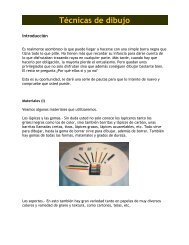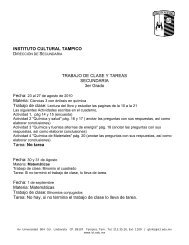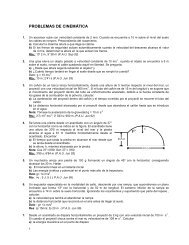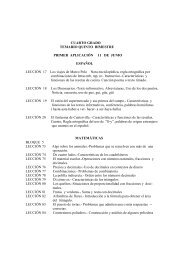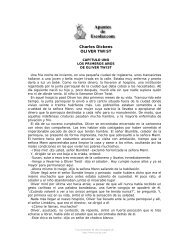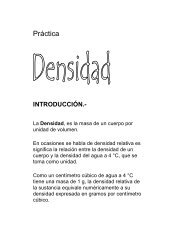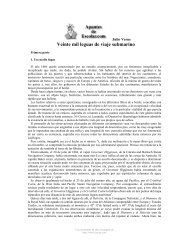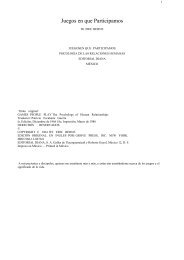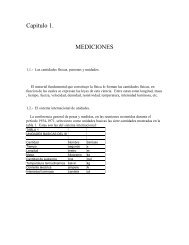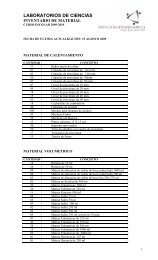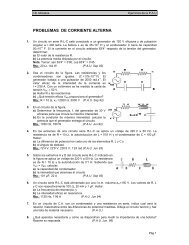- Page 1:
Carlos Ivorra Castillo TEORÍA DE N
- Page 5 and 6:
Índice General Prefacio ix Capítu
- Page 7:
ÍNDICE GENERAL vii 11.7 Enteros ci
- Page 11 and 12:
Capítulo I Introducción a la teor
- Page 13 and 14:
1.2. El Último Teorema de Fermat 3
- Page 15 and 16:
1.3. Factorización única 5 El nom
- Page 17 and 18:
1.3. Factorización única 7 La cla
- Page 19 and 20:
1.4. La ley de reciprocidad cuadrá
- Page 21 and 22:
1.5. El teorema de Dirichlet 11 das
- Page 23 and 24:
1.6. Ecuaciones diofánticas 13 un
- Page 25 and 26:
1.7. Ecuaciones definidas por forma
- Page 27 and 28:
1.7. Ecuaciones definidas por forma
- Page 29 and 30:
Capítulo II Cuerpos numéricos El
- Page 31 and 32:
2.1. Enteros algebraicos 21 Teorema
- Page 33 and 34:
2.2. Discriminantes 23 Demostració
- Page 35 and 36:
2.3. Módulos y órdenes 25 Ejercic
- Page 37 and 38:
2.3. Módulos y órdenes 27 Ejemplo
- Page 39 and 40:
2.3. Módulos y órdenes 29 Demostr
- Page 41 and 42:
2.3. Módulos y órdenes 31 Es impo
- Page 43 and 44:
2.4. Determinación de bases entera
- Page 45 and 46:
2.4. Determinación de bases entera
- Page 47 and 48:
2.4. Determinación de bases entera
- Page 49 and 50:
2.4. Determinación de bases entera
- Page 51 and 52:
2.4. Determinación de bases entera
- Page 53 and 54:
2.4. Determinación de bases entera
- Page 55 and 56:
2.5. Normas e Índices 45 Demostrac
- Page 57:
2.5. Normas e Índices 47 Por lo ta
- Page 60 and 61:
50 Capítulo 3. Factorización idea
- Page 62 and 63:
52 Capítulo 3. Factorización idea
- Page 64 and 65:
54 Capítulo 3. Factorización idea
- Page 66 and 67:
56 Capítulo 3. Factorización idea
- Page 68 and 69:
58 Capítulo 3. Factorización idea
- Page 70 and 71:
60 Capítulo 3. Factorización idea
- Page 72 and 73:
62 Capítulo 3. Factorización idea
- Page 74 and 75:
64 Capítulo 3. Factorización idea
- Page 76 and 77:
66 Capítulo 3. Factorización idea
- Page 78 and 79:
68 Capítulo 3. Factorización idea
- Page 80 and 81:
70 Capítulo 3. Factorización idea
- Page 82 and 83:
72 Capítulo 3. Factorización idea
- Page 84 and 85:
74 Capítulo 3. Factorización idea
- Page 86 and 87:
76 Capítulo 3. Factorización idea
- Page 88 and 89:
78 Capítulo 4. Métodos geométric
- Page 90 and 91: 80 Capítulo 4. Métodos geométric
- Page 92 and 93: 82 Capítulo 4. Métodos geométric
- Page 94 and 95: 84 Capítulo 4. Métodos geométric
- Page 96 and 97: 86 Capítulo 4. Métodos geométric
- Page 98 and 99: 88 Capítulo 4. Métodos geométric
- Page 100 and 101: 90 Capítulo 4. Métodos geométric
- Page 102 and 103: 92 Capítulo 4. Métodos geométric
- Page 104 and 105: 94 Capítulo 4. Métodos geométric
- Page 106 and 107: 96 Capítulo 4. Métodos geométric
- Page 108 and 109: 98 Capítulo 4. Métodos geométric
- Page 110 and 111: 100 Capítulo 4. Métodos geométri
- Page 112 and 113: 102 Capítulo 4. Métodos geométri
- Page 114 and 115: 104 Capítulo 4. Métodos geométri
- Page 116 and 117: 106 Capítulo 4. Métodos geométri
- Page 118 and 119: 108 Capítulo 4. Métodos geométri
- Page 120 and 121: 110 Capítulo 4. Métodos geométri
- Page 122 and 123: 112 Capítulo 5. Fracciones continu
- Page 124 and 125: 114 Capítulo 5. Fracciones continu
- Page 126 and 127: 116 Capítulo 5. Fracciones continu
- Page 128 and 129: 118 Capítulo 5. Fracciones continu
- Page 130 and 131: 120 Capítulo 5. Fracciones continu
- Page 132 and 133: 122 Capítulo 5. Fracciones continu
- Page 134 and 135: 124 Capítulo 5. Fracciones continu
- Page 136 and 137: 126 Capítulo 5. Fracciones continu
- Page 138 and 139: 128 Capítulo 5. Fracciones continu
- Page 142 and 143: 132 Capítulo 6. Cuerpos cuadrátic
- Page 144 and 145: 134 Capítulo 6. Cuerpos cuadrátic
- Page 146 and 147: 136 Capítulo 6. Cuerpos cuadrátic
- Page 148 and 149: 138 Capítulo 6. Cuerpos cuadrátic
- Page 150 and 151: 140 Capítulo 6. Cuerpos cuadrátic
- Page 152 and 153: 142 Capítulo 6. Cuerpos cuadrátic
- Page 154 and 155: 144 Capítulo 6. Cuerpos cuadrátic
- Page 156 and 157: 146 Capítulo 6. Cuerpos cuadrátic
- Page 158 and 159: 148 Capítulo 6. Cuerpos cuadrátic
- Page 160 and 161: 150 Capítulo 6. Cuerpos cuadrátic
- Page 162 and 163: 152 Capítulo 6. Cuerpos cuadrátic
- Page 164 and 165: 154 Capítulo 6. Cuerpos cuadrátic
- Page 167 and 168: Capítulo VII Números p-ádicos En
- Page 169 and 170: 7.1. Valores absolutos 159 Propieda
- Page 171 and 172: 7.1. Valores absolutos 161 Isometr
- Page 173 and 174: 7.1. Valores absolutos 163 Demostra
- Page 175 and 176: 7.2. Cuerpos métricos discretos 16
- Page 177 and 178: 7.2. Cuerpos métricos discretos 16
- Page 179 and 180: 7.2. Cuerpos métricos discretos 16
- Page 181 and 182: 7.3. Criterios de existencia de ra
- Page 183 and 184: 7.4. Series en cuerpos no arquimedi
- Page 185 and 186: 7.4. Series en cuerpos no arquimedi
- Page 187 and 188: 7.4. Series en cuerpos no arquimedi
- Page 189 and 190: 7.4. Series en cuerpos no arquimedi
- Page 191 and 192:
Capítulo VIII El teorema de Hasse-
- Page 193 and 194:
8.1. Formas cuadráticas 183 que w
- Page 195 and 196:
8.2. Formas cuadráticas sobre cuer
- Page 197 and 198:
8.2. Formas cuadráticas sobre cuer
- Page 199 and 200:
8.2. Formas cuadráticas sobre cuer
- Page 201 and 202:
8.3. Formas binarias en cuerpos p-
- Page 203 and 204:
8.3. Formas binarias en cuerpos p-
- Page 205 and 206:
8.3. Formas binarias en cuerpos p-
- Page 207 and 208:
8.4. El teorema de Hasse-Minkowski
- Page 209 and 210:
8.4. El teorema de Hasse-Minkowski
- Page 211 and 212:
8.5. La ley de reciprocidad cuadrá
- Page 213 and 214:
8.6. Conclusión de la prueba 203 M
- Page 215 and 216:
8.6. Conclusión de la prueba 205 R
- Page 217:
8.6. Conclusión de la prueba 207 T
- Page 220 and 221:
210 Capítulo 9. La teoría de los
- Page 222 and 223:
212 Capítulo 9. La teoría de los
- Page 224 and 225:
214 Capítulo 9. La teoría de los
- Page 226 and 227:
216 Capítulo 9. La teoría de los
- Page 228 and 229:
218 Capítulo 9. La teoría de los
- Page 230 and 231:
220 Capítulo 9. La teoría de los
- Page 232 and 233:
222 Capítulo 9. La teoría de los
- Page 234 and 235:
224 Capítulo 9. La teoría de los
- Page 236 and 237:
226 Capítulo 9. La teoría de los
- Page 238 and 239:
228 Capítulo 9. La teoría de los
- Page 240 and 241:
230 Capítulo 9. La teoría de los
- Page 242 and 243:
232 Capítulo 9. La teoría de los
- Page 244 and 245:
234 Capítulo 9. La teoría de los
- Page 246 and 247:
236 Capítulo 9. La teoría de los
- Page 248 and 249:
238 Capítulo 9. La teoría de los
- Page 250 and 251:
240 Capítulo 9. La teoría de los
- Page 252 and 253:
242 Capítulo 9. La teoría de los
- Page 254 and 255:
244 Capítulo 9. La teoría de los
- Page 256 and 257:
246 Capítulo 9. La teoría de los
- Page 258 and 259:
248 Capítulo 9. La teoría de los
- Page 260 and 261:
250 Capítulo 9. La teoría de los
- Page 262 and 263:
252 Capítulo 9. La teoría de los
- Page 264 and 265:
254 Capítulo 10. El Último Teorem
- Page 266 and 267:
256 Capítulo 10. El Último Teorem
- Page 268 and 269:
258 Capítulo 10. El Último Teorem
- Page 270 and 271:
260 Capítulo 10. El Último Teorem
- Page 272 and 273:
262 Capítulo 11. La función dseta
- Page 274 and 275:
264 Capítulo 11. La función dseta
- Page 276 and 277:
266 Capítulo 11. La función dseta
- Page 278 and 279:
268 Capítulo 11. La función dseta
- Page 280 and 281:
270 Capítulo 11. La función dseta
- Page 282 and 283:
272 Capítulo 11. La función dseta
- Page 284 and 285:
274 Capítulo 11. La función dseta
- Page 286 and 287:
276 Capítulo 11. La función dseta
- Page 288 and 289:
278 Capítulo 11. La función dseta
- Page 290 and 291:
280 Capítulo 11. La función dseta
- Page 292 and 293:
282 Capítulo 11. La función dseta
- Page 294 and 295:
284 Capítulo 11. La función dseta
- Page 296 and 297:
286 Capítulo 11. La función dseta
- Page 298 and 299:
288 Capítulo 11. La función dseta
- Page 300 and 301:
290 Capítulo 11. La función dseta
- Page 302 and 303:
292 Capítulo 11. La función dseta
- Page 304 and 305:
294 Capítulo 11. La función dseta
- Page 306 and 307:
296 Capítulo 11. La función dseta
- Page 308 and 309:
298 Capítulo 11. La función dseta
- Page 310 and 311:
300 Capítulo 12. Sumas de Gauss Se
- Page 312 and 313:
302 Capítulo 12. Sumas de Gauss Te
- Page 314 and 315:
304 Capítulo 12. Sumas de Gauss Cl
- Page 316 and 317:
306 Capítulo 12. Sumas de Gauss De
- Page 318 and 319:
308 Capítulo 12. Sumas de Gauss Ad
- Page 320 and 321:
310 Capítulo 12. Sumas de Gauss De
- Page 322 and 323:
312 Capítulo 12. Sumas de Gauss Po
- Page 325 and 326:
Capítulo XIII Cuerpos ciclotómico
- Page 327 and 328:
13.2. El primer factor del número
- Page 329 and 330:
13.2. El primer factor del número
- Page 331 and 332:
13.2. El primer factor del número
- Page 333 and 334:
13.3. Los números de Bernoulli 323
- Page 335 and 336:
13.3. Los números de Bernoulli 325
- Page 337 and 338:
13.3. Los números de Bernoulli 327
- Page 339 and 340:
13.4. El segundo factor del número
- Page 341 and 342:
13.4. El segundo factor del número
- Page 343 and 344:
13.5. Numeros p-ádicos ciclotómic
- Page 345 and 346:
13.5. Numeros p-ádicos ciclotómic
- Page 347 and 348:
13.6. La caracterización de los pr
- Page 349 and 350:
13.6. La caracterización de los pr
- Page 351 and 352:
13.6. La caracterización de los pr
- Page 353 and 354:
13.6. La caracterización de los pr
- Page 355:
13.6. La caracterización de los pr
- Page 358 and 359:
348 Capítulo 14. Números trascend
- Page 360 and 361:
350 Capítulo 14. Números trascend
- Page 362 and 363:
352 Capítulo 14. Números trascend
- Page 364 and 365:
354 Capítulo 14. Números trascend
- Page 366 and 367:
356 Capítulo 14. Números trascend
- Page 368 and 369:
358 Capítulo 14. Números trascend
- Page 370 and 371:
360 Capítulo 14. Números trascend
- Page 373:
Bibliografía [1] Baker, A. Breve i
- Page 376 and 377:
Índice de Materias algebraico, 13
- Page 378:
por una forma, 180 resto cuadrátic



